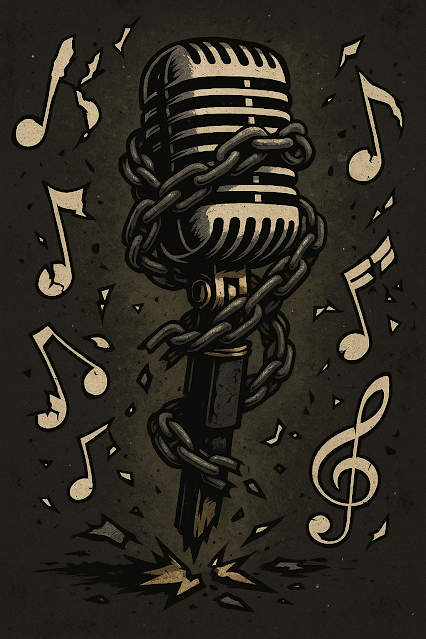When Warnings Become Blueprints: How Power Co-opts Critique to Sustain Control
Title: When Warnings Become Blueprints: How Power Co-opts Critique to Sustain Control
Introduction What happens when a warning becomes a how-to manual? In recent years, scholars and thinkers have found their cautionary frameworks—intended as red flags—repurposed by the very systems they critiqued. A striking example comes from political scientists Henry Farrell and Abraham Newman, who coined the term "weaponized interdependence" to describe how powerful nations exploit global networks for surveillance and coercion. Their intention was to highlight a dangerous imbalance. Instead, policymakers interpreted it as strategic advice. This intellectual inversion is not an anomaly—it's a consistent pattern.
This article explores how critiques meant to expose abuse are routinely transformed into justifications for further control, with particular attention to policy and media. These distortions don't just reflect misunderstanding; they serve as instruments of manipulation. The result is a society where resistance is neutered, dissent co-opted, and systems of power further entrenched.
1. From Irony to Ideology: The Bootstrap Paradox
The phrase "pull yourself up by your bootstraps" is an apt metaphor for how critique becomes propaganda. Originally meant as satire—a literal impossibility used to mock delusions of self-sufficiency—it evolved into the cornerstone of a neoliberal meritocracy. The irony was lost, then repurposed.
This rhetorical shift had real policy consequences. The idea that anyone can succeed if they just try hard enough was used to justify cuts to social safety nets, defund public services, and demonize the poor. Structural inequality was reframed as individual failure. An absurdist joke became a moral imperative.
2. Weaponized Interdependence: Case Study in Strategic Misuse
Henry Farrell and Abraham Newman's work on global economic and communication networks illustrated how U.S. control over systems like SWIFT or DNS root zones could be used to pressure or punish adversaries. Their research was a mirror held up to an empire’s soft power.
But rather than provoke reflection or reform, their terminology was co-opted by national security professionals and used in policy papers and think tank strategy sessions as a viable model of power projection. The authors later expressed regret that what was meant to be a warning became a toolkit.
This is a common fate for frameworks that expose systemic abuse: they are quickly reframed as necessary tools for geopolitical advantage.
3. Media Echo Chambers and the Simplification of Dissent
Mainstream media plays a critical role in laundering these inversions. Complex critiques are distilled into bite-sized talking points, often stripped of context or subtext. When George Orwell's 1984 is invoked by tech executives or politicians to criticize their enemies—while they themselves implement surveillance tools or censorship mechanisms—we see a recursive irony that Orwell himself would likely mock.
Even protest movements are susceptible. Phrases like “Black Lives Matter” or “Defund the Police” are diluted in media narratives, reframed as extremist, chaotic, or unrealistic, then trotted out as evidence that reform is unnecessary or dangerous. The original intent is hollowed out until what remains is a rhetorical shell that supports the status quo.
4. Discursive Capture: Co-opting the Language of Resistance
This phenomenon is sometimes referred to as discursive capture—when the vocabulary of opposition is absorbed into dominant discourse, neutralizing its revolutionary potential. Consider how corporations use the language of sustainability while engaging in greenwashing, or how militaries adopt diversity initiatives to mask imperial missions under a veneer of social progress.
Orwellian doublespeak isn’t just fiction—it’s strategic. By allowing just enough critique within the system, power gives the illusion of self-correction. But if the critique has been rewritten to serve the system, the correction never comes.
5. The Historical Pattern of Co-opted Critique
• Orwell’s 1984 and Animal Farm: Both intended as anti-authoritarian parables, yet often cited by reactionaries to condemn leftist ideals while ignoring their own authoritarian impulses.
• Nietzsche’s "Will to Power": Twisted by fascist ideologues despite Nietzsche’s rejection of nationalism and antisemitism.
• MLK’s Legacy: Sanitized into a symbol of passive resistance and racial unity, while his criticisms of capitalism, white moderates, and the military-industrial complex are almost entirely scrubbed from public remembrance.
• Occupy Wall Street: Its rhetoric around the 99% was absorbed into advertising, political campaigns, and even financial institutions, defanging its radical edge.
6. Why This Strategy Works
• Simplification over Nuance: Complex critiques require effort to understand, making them easy targets for reduction and misrepresentation.
• Elite Incentives: Power has no incentive to engage with critique honestly. Co-optation offers control without confrontation.
• Public Distraction: By reframing critique as support, power diverts attention from systemic change to performative gestures.
• Platform Algorithms: Social media favors brevity and outrage over depth and clarity. This accelerates the distortion process.
7. How to Spot and Resist the Inversion
• Interrogate Origin Stories: Ask what the original message or critique was and compare it to current usage.
• Trace the Money and Power: Who benefits from the reinterpretation?
• Demand Contextual Integrity: Hold media and policymakers accountable for using intellectual frameworks honestly.
• Support Independent Scholarship: Academics and thinkers often lose control of their work once it enters mainstream policy discourse. Independent platforms help preserve original intent.
Conclusion: The Danger of Being Right Too Early
Warnings, when ignored, are bad enough. But when they’re appropriated by the powerful, they become something more insidious: tools of control masquerading as insight. Whether through irony turned ideology, critique turned strategy, or dissent turned brand, the appropriation of resistance language is a core feature of modern governance and media.
To protect critical thought from being twisted into a weapon of the very systems it warns against, we must learn not only to hear warnings—but to recognize when others are using them to tighten their grip.
It’s not just about what’s being said. It’s about who’s saying it, why they’re saying it, and what they’ve chosen to ignore.




Comments
Post a Comment